Types of Small Black Bugs (With Pictures) – Identification
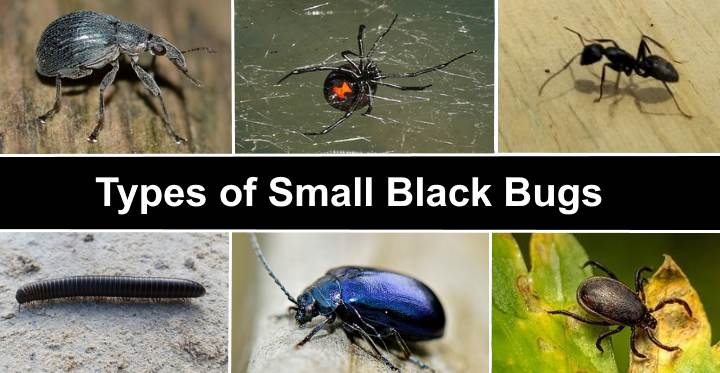
No one wants to find small black bugs in the house. Small black insects crawling, scurrying, or slithering across a floor could be a beetle, spider, black ant, cockroach, or pillbug. But there are also tiny black bugs that are difficult to spot because they lurk in crevices or only come out at night. In some cases, the only signs of little black bugs are red, itchy, bite marks they leave on your skin.
Knowing how to identify small black house bugs is crucial if you want to eradicate them. Some types of black beetles, weevils, and ants are attracted to foodstuffs in your pantry. Black flying bugs could be a sign of a plant infestation or rotten food in your kitchen. However, certain black spiders like the black widow are dangerous arthropods that can inflict a nasty bite.
Many people refer to all dark brown or black house pests as bugs. However, not all insects are classified as true bugs. In scientific terms, a true bug is an insect in the order Hemiptera, and it has specialized mouthparts to suck plant juices or blood. This article refers to all pesky black insects or arthropods as house bugs.
In this article, you will find out how to identify common types of tiny black bugs commonly found in houses. In addition, you will also get helpful tips on getting rid of the black bugs if the critters are causing a nuisance.
How to Identify Small Black Bugs
Identifying types of small black bugs is possible by looking at the pest’s shape and if it has legs, wings, or a hard shell. However, identifying some black bugs is challenging because they are so tiny you need a microscope to distinguish their characteristics.
In addition to looking at visual features of the black nuisance pests, it’s vital to observe their habits, behavior, and where they are lurking. For example, some tiny black beetles look like bed bugs. But unlike bed bugs, they don’t congregate in clusters behind beds.
Tiny Black Bugs
Tiny black bugs can be little dark brown or black insects ranging from a pinhead to a grain of rice or apple seed size. Types of small black bugs include ticks, bed bugs, and fleas. Most of the time, you’ll only spot these minuscule bugs when they bite your skin, leaving an itchy red bump.
Small black bugs
Small black bugs can be tiny nuisance creatures like ants, beetles, weevils, or pirate bugs. Beetles and weevils are easy to identify because they have distinguishing hard shells covering two sets of wings and six legs. Small black ants have a recognizable slender body and tiny waist.
Small Black Bugs in the House (With Pictures and Names) – Identification Guide
Let’s look in more detail at the identifying characteristics of tiny black bugs you are likely to find in the house.
Black Carpet Beetle (Attagenus unicolor)
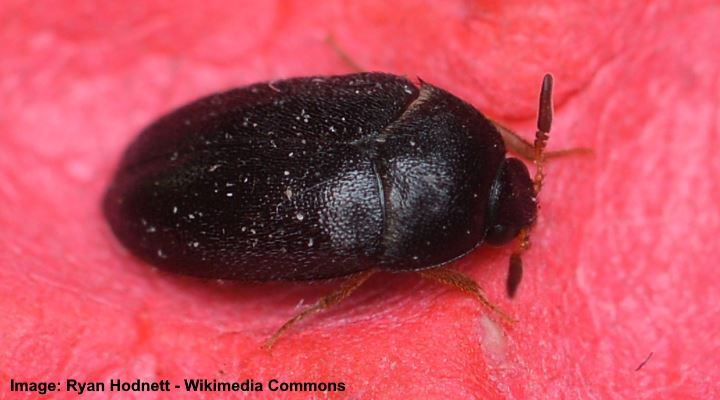
The black carpet beetle is a tiny bug that infests carpets and fabrics in the house
A black carpet beetle has a black oval body, a hard shell covering four wings, six legs, and two stumpy antennae. These nuisance flying pests that infest carpets and soft furnishings can also be black with yellow and white patterns. The tiny, winged pests measure 0.12” to 0.2 (3 – 5 mm) long.
Adult black carpet beetles are usually spotted flying inside the house. They are white to start with but gradually turn black as the flying bugs mature. Reddish-brown colored carpet beetle larvae typically do the most damage by chewing through natural fibers like wool, silk, leather, and fur.
To get rid of tiny black carpet beetles, you can use a vacuum cleaner or steam cleaner to remove the larvae from curtains, rugs, carpets, and furniture.
Small Black Bug Identification: Adult carpet beetles have an identifiable hard, oval black or black and brown body with mottled patterns.
Black Weevils – Pantry Bugs
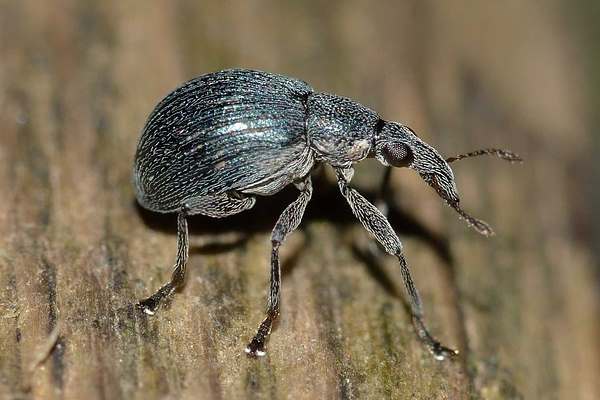
Weevils are small black beetles that can easily infest foodstuffs in your house
Black weevils are tiny, slender beetles with a long snout and are often found in stored grains. Because the little black bugs are found in foodstuffs, they are also called pantry bugs or pests. The dark beetles can range in color from dark reddish-brown to nearly black. Adult weevil bugs usually measure up to 0.24” (6 mm) long.
Several types of black weevil are classified as pantry pests. Usually, the common name of the bug tells you where it usually hides. For example, there are rice weevils, grain weevils, maize weevils, granary weevils, and bean weevils.
To get rid of black weevils, it’s necessary to thoroughly clean the insides of your kitchen cabinet shelves and pantry. First, use a vacuum to get rid of the bugs and their larvae. Then wash down the cabinet interiors with hot soapy water.
Small Black Bug Identification: The identifying feature of a black weevil is its recognizable long snout and slender body.
Fleas (Siphonaptera)
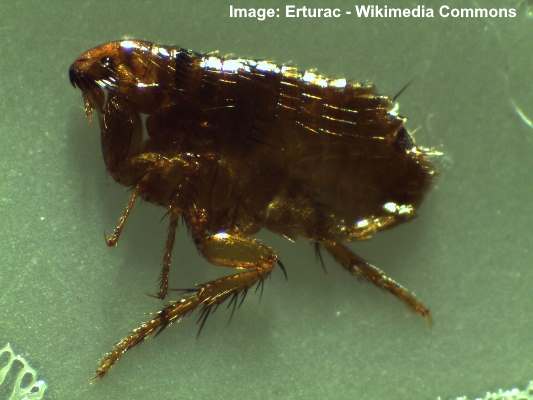
A close up picture of a flea
Fleas are disgusting, disease-carrying tiny brown bugs that look black. Fleas are so tiny that they are difficult to spot. In addition, they can jump huge distances and seem to disappear before your eyes. Fleas have a minute brown or black oval body and measure around 0.12” (3 mm) long.
When looking at fleas closely, they may appear as small, dark specks or dots, similar to poppy seeds. Due to their small size and dark coloration, they can be easily mistaken for dirt or specks of debris on the surface of the host’s skin or fur.
Fleas get into the house on dogs, cats, old furniture, or even a person who is infested. Fleas cause a nuisance because they are blood-sucking biting pests. A flea bite can cause an itchy red bump to appear.
To get rid of tiny black fleas, it’s vital to steam clean upholstery, carpets, and pet bedding. Hot steam should kill fleas on contact. In addition, it may be necessary to get a flea collar for your pet cat or dog to prevent more issues with fleas.
Small Black Bug Identification: Fleas are tiny, almost microscopic black-looking bugs. You can only see their identifying characteristics under a microscope. You may also spot the signs of fleas if your pets itch constantly or you have tiny bite marks on your skin.
Bed Bugs (Cimex)

Enlarged picture of a bed bug – The tiny brown bed bugs look black but are actually brown
Bed bugs are irritating dark-colored insects with a flattened oval body that is dark brown, almost black. Bed bugs are hard to spot because they lurk in dark crevices of bed frames and furniture and only come out at night. The minuscule dark bugs have wings but can’t fly and grow 0.16 – 0.2 (1.5 – 3 mm) long.
You can usually find bed bugs in the seams of mattresses, in box springs, bed frames, and behind headboards. The pesky critters are so invasive they may inhabit electrical outlets, hide under loose wallpaper, or in cracks the width of a credit card.
Getting rid of a bed bug infestation is notoriously tricky. According to the Environmental Protection Agency (EPA), there is no quick fix for bed bug eradication. In some cases, you may have to call in the professionals.
Small Black Bug Identification: Bed bugs are usually identified by the bite marks they leave behind. The red itchy bumps can measure up to (5 mm) and be on your arms, legs, back, abdomen, or face. What makes bed bugs even more challenging to identify is that symptoms may only appear a few days after biting.
Black Carpenter Ants (Camponotus)

Black carpenter ants are little bugs that nest in old dried wood
Black carpenter ants have a slender black body with a thin waist and bulbous abdomen. The ant’s six legs are attached to its thorax. You can tell ants apart from other bugs due to their angled antennae and spindly appearance. Tiny black carpenter ants measure 0.6” (16 mm) long.
Carpenter ants usually tunnel into deadwood to build their nests. Signs of a carpenter ant infestation include sawdust-like shavings and molted bodies near holes in wood. Another issue with these pesky black bugs is that they give you a nasty bite that causes a burning sensation.
Some of the slim black creeping bugs also have wings and can fly. These are the carpenter ant swarmers, however both the worker ants and queen don’t have wings.
To get rid of carpenter ants, it’s vital to reduce moisture and humidity in the house. Also, it’s necessary to caulk cracks where the black ants could get into the house. In some cases, ant traps can help to reduce the number of ants.
Small Black Bug Identification: Black ants have an identifiable slender body with an oval abdomen, six spindly black legs, and two long antennae.
Black Garden Ant (Lasius niger)
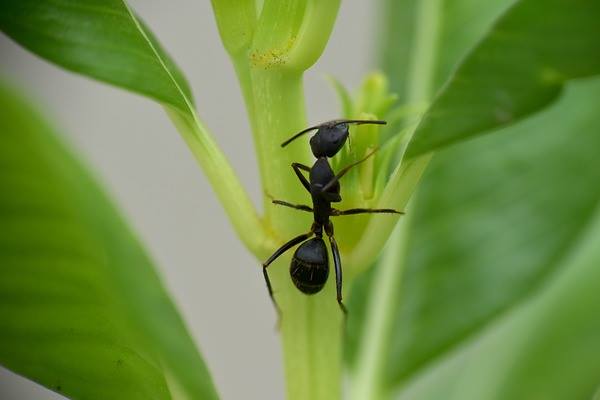
Black garden ants can get into the house and are attracted especially to sweet soft fruit
Garden ants are slim, shiny black bugs that are more of a nuisance pest than a dangerous biting critter. Black garden ants become house pests when they enter homes foraging for food. Unlike carpenter ants, garden ants don’t bite, and they don’t carry disease. Garden ants are typically 0.2” (5 mm) long.
To prevent black ants from becoming a nuisance bug, it’s crucial to stop them from getting into the house. This means sealing up any cracks around windows or door frames and pipes entering the building. Additionally, sweet, soft-skinned fruit attracts ants. So, keep food sealed to remove the pest’s food source.
Black ants can be an indirect pest for gardeners. The black ants protect aphids so that the plant-destroying pests can provide plenty of honeydew.
Small Black Bug Identification: A black garden ant is identified by its shiny black body, spindly brown or black legs, and a bulbous abdomen.
Centipedes

Centipedes are long creepy house bugs that are identified by numerous pairs of legs
Centipedes are long brown to dark brown, almost black bugs that are attracted to moisture. Centipedes are easy to spot due to their numerous pairs of legs along their segmented body. Some black centipedes have brown legs and a black body; others have dark brown to light brown bodies.
Centipedes range in size from a fraction of an inch to 12” (30 cm) long. Depending on the species of black centipede, the creeping bugs can have between 30 and 354 legs.
Centipedes are more than an annoying black house pest. The slithering bugs have a venomous bite, and that can inflict a lot of pain. So, if you see the long, multi-legged creatures, it’s best to kill them. It’s also a good idea to avoid attracting centipedes into the house by keeping garden debris away from buildings.
In the house, the long crawling black insects are typically found in dark, damp areas. You may find them in crawl spaces, basements, closets, or other dark places.
Small Black Bug Identification: Black centipedes are easy to identify due to their multiple pairs of legs, two tails, and long antennae.
Black-Legged Tick (Ixodes scapularis)

Black-legged male tick (left) is smaller and black, whereas the female (right) is black and brown
The black-legged tick or deer tick is a tiny black and brown bug that carries numerous diseases. Black ticks feed on animal and human blood. The ticks have a flattened oval body and are about the size of a sesame seed. The tiny brown and black bugs measure 0.11” (3 mm) long and have eight legs.
The disease-carrying black bug uses its mouthparts to pierce the skin and burrow into the skin. Ticks then attach themselves while they suck on blood.
Apart from finding a repulsive engorged tick on your skin, the symptoms of a tick bite are pain, swelling, and a burning sensation. It’s always best to get medical attention after a tick bite to get the necessary treatment and remove the tick properly.
Small Black Bug Identification: A tick is identified by its flattened tiny black or brown body and eight legs. Male ticks are entirely black or dark brown, whereas females are larger and have a black head and red abdomen.
Fungus Gnats
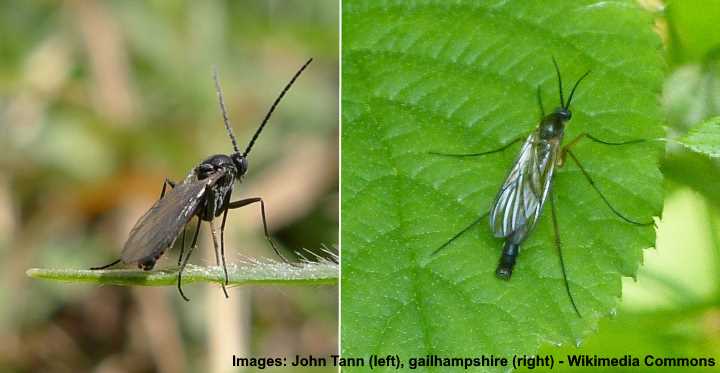
Fungus gnats are black flying bugs that can infest houseplants and damp areas
Fungus gnats are annoying black flies with a long slender body like a mosquito. The pesky black flies can grow 0.08” to 0.3” (2 – 8 mm) long, and they have six legs, translucent wings, and a pair of antennae. In the house, you will often see the tiny black flies crawling on houseplants or hovering above them.
Fungus gnats are irritating as they fly around your face, nose, and eyes. The small black flies are sometimes mistaken for drain flies, which are tiny gray flies. However, you can usually spot the flying bugs near potted plants.
The best way to prevent fungus gnat is to look after houseplants properly by avoiding overwatering them. This is because the irritating flying black bugs are attracted to damp soil. To get rid of fungus gnats, you can make a DIY neem oil spray to kill the houseplant pests.
Small Black Bug Identification: Fungus gnats are slender black flies that infest potted plants, damp areas, and garden areas with poor drainage.
Pirate Bugs (Anthocoridae)
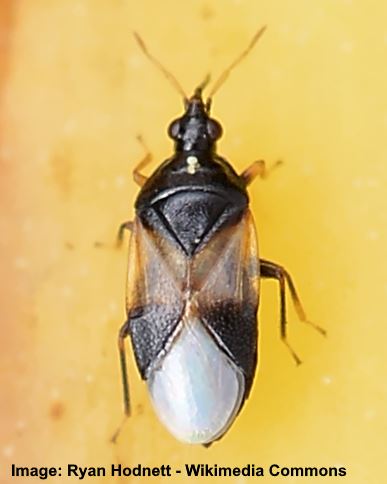
The tiny black and white pirate bugs are good for natural pest control and rarely infest homes
Pirate bugs are black and white pests with two pairs of wings, an elongated, soft, flat body, and two long antennae. Pirate bugs are “true bugs” in the order Hemiptera. They have characteristic piercing and sucking mouthparts to inject prey and feed. Black and white pirate bugs measure 0.06” to 0.2” (1.5 – 5 mm) long.
Minute pirate bugs are also called flower bugs. They are beneficial insects that will feed on aphids, whiteflies, small caterpillars, and mite eggs.
Although pirate bugs are good for natural pest control, the tiny black bugs can inflict a painful bite. In some cases, an allergic reaction can cause the skin to swell up like a mosquito bite. However, the tiny bugs rarely infest homes. Instead, they are most likely to bite you when working in the garden in the fall.
Small Black Bug Identification: Pirate bugs have an identifiable black and white oval body. Their wings allow them to fly short distances.
Small Black Bugs with Hard Shell (With Pictures and Names) – Identification Guide
Let’s look at some small black bugs that are identified by their hard shell and black appearance.
Pillbugs (Armadillidiidae)
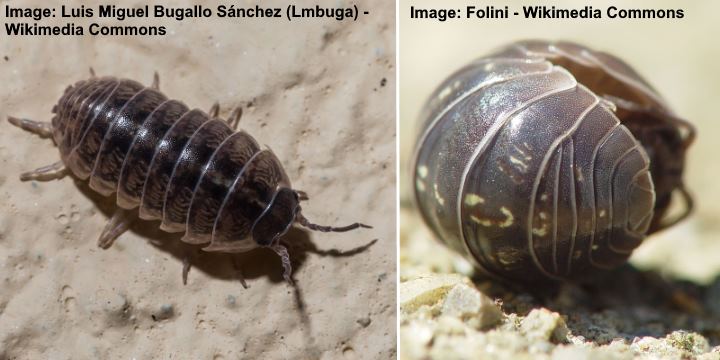
Pillbugs have dark hard segmented shell and can roll when they feel threatened
Pillbugs are tiny grayish-black bugs that look as if they have armor plating. The bugs from the woodlice family have a segmented black oval body, multiple legs, and two antennae. You will often find pillbugs in dark, damp places, and they have the recognizable habit of rolling into a ball.
Pillbugs measure up to 0.7” (18 mm) long. The hard-shelled black bugs are also called potato bugs, slaters, doodle bugs, or roly-polies.
To get rid of pillbugs, remove all traces of excess moisture and seal all cracks and gaps in your home’s exterior. Also, keep garden debris, weeds, and leaf piles well away from your house.
Small Black Bug Identification: Pillbugs are identified by their dark-gray hard shell that looks like an armadillo.
Oriental Cockroach or Waterbug (Blatta orientalis)
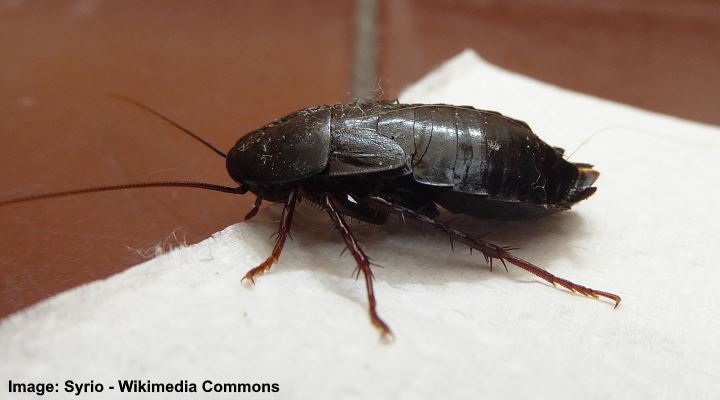
Waterbug are small black bugs with hard shell and two long antennae
Most cockroaches are brown bugs. But the Oriental cockroach is a nasty black bug with a hard shell, six legs, and two arched antennae. These nocturnal black bugs are a significant pest in homes that lurk in dark, warm, humid places. Black Oriental cockroaches measure between 1” and 1.2” (25 to 30 mm).
It’s vital to get rid of oriental cockroaches from your home because they carry disease. First, it’s crucial to disrupt their environment to prevent a cockroach infestation. Therefore, you should sanitize drains, keep a tight lid on the trash can, and fix any plumbing issues.
You can try using diatomaceous earth as a natural, non-toxic pesticide to kill bugs in the home.
Small Black Bug Identification: An Oriental cockroach is identified by its elongated oval black body, six brown spiny legs, and two long antennae.
Black Widow Spider (Latrodectus)

Black widow spider are found in dark areas and can inflict a nasty bite
The black widow spider is a serious pest in the house because the round, shiny black spider has a nasty bite. A black widow spider has a rounded, bulbous coal-black abdomen with a distinctive red hourglass marking. Black widow spiders range in size from 0.12” to 0.4” (3 – 10 mm).
Black widows tend to be reclusive spiders that lurk in dark areas. You will usually tell if there is a black widow spider by its distinctive tangle web and haphazard shape. The best way to get rid of dangerous black spiders is to vacuum the spiders using the hose attachment.
Small Black Bug Identification: Black widow spiders are easy to identify due to their rounded ball-like pitch-black, shiny abdomen with identifiable red markings.
Related articles:
